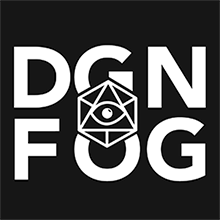Damage, Injury, and Dying
Damage Types
- Physical: Unarmed attacks, blunt force, slashing and stabbing, ballistics.
- Energy: Laser, plasma, and flame weapons.
- Radiation: Exposure to RADs, or nuclear weaponry.
- Poison: Toxins, chemicals, and creatures’ stings and barbs.
Each target has a Damage Resistance (DR) for each of these types, based on their clothing, armor, or naturally tough hides and chitin. While most forms of protection provide physical DR, energy DR is rarer, while radiation or poison protection can be particularly rare.
Damage Effects
Damage effects augment how the damage you inflict to a target is applied. When you roll one or more CD symbols (5 or 6) in your Combat Dice pool, all your weapon’s damage effects are triggered. Some damage effects are also based on the number of CD symbols appearing in your result, as described in each entry. Each weapon lists its damage effects immediately after its damage rating.
- Burst: The attack hits one additional target within Close range of the primary target for each Effect rolled. Each additional target spends 1 additional unit of ammunition from the weapon.
- Breaking: For each Effect rolled, reduce the number of CD a target’s cover provides by 1, permanently. If the target is not in cover, instead reduce the DR of the location struck by 1, according to the damage type of the weapon—physical damage only reduces physical DR, for example.
- Persistent: If one or more Effects are rolled, the target suffers the weapon’s damage again at the end of their next and subsequent turns, for a number of rounds equal to the number of Effects rolled. The target can spend a major action to make a test to stop persistent damage early, with the difficulty equal to the number of Effects rolled, and the attribute + skill chosen by the GM. Some Persistent weapons may inflict a different type of damage to the weapon, and where this is the case, it will be noted in brackets, for example: Persistent (Poison).
- Piercing X: Ignore X points of the target’s DR for each Effect rolled, where X is the rating of this damage effect.
- Radioactive: For every Effect rolled, the target also suffers 1 point of radiation damage. This radiation damage is totalled and applied separately, after a character has suffered the normal damage from the attack.
- Spread: For each Effect rolled, your attack inflicts one additional hit on the target. Each additional hit inflicts half the rolled damage (rounded down) and hits a random location even if a specific location was targeted for the initial attack.
- Stun: If one or more Effects are rolled, the target cannot take their normal actions on their next turn. A stunned character or creature can still spend AP to take additional actions as normal.
- Vicious: The attack inflicts +1 damage for each Effect rolled.
Radiation Damage
Radiation damage is applied differently than other damage types. Each point of radiation damage, after reduction for the location’s radiation DR, reduces a character’s maximum health points, rather than their current health points. If a character’s health point maximum is reduced below their current health point total, then their current HP are reduced as well.
Radiation damage is only reduced by a target’s radiation Damage Resistance, according to the location hit. If the radiation would affect the whole body, like an environmental effect, then use the character or creature’s lowest locational radiation DR.
In all cases, where a character would suffer radiation damage and another type of damage at the same time, resolve the radiation damage after any other types of damage.
Example: Piper is attacked by a glowing feral ghoul, taking 3 CD Radioactive damage. The GM rolls their CD and totals 4 damage with an Effect, inflicting 4 physical damage and 1 radiation damage. Piper has 2 physical resistance, so she reduces her current health points by 2. Then, she reduces her maximum health points by 1 because of the radiation damage.
A character that has lost health points (HP) isn’t seriously hurt—they may have suffered scratches, scrapes, cuts and bruises—but nothing that would hinder them. However, once a character’s health points are reduced to 0, they are defeated, and begin dying. In addition, characters may suffer from serious injuries as a result of being reduced to 0 HP, or as a result of critical hits.
Critical Hits and Injuries
A critical hit occurs whenever a character suffers five or more damage in one hit (after reductions from Damage Resistance). A critical hit imposes an injury on the character, which confers a penalty depending on the location hit.
- Arm: You drop any object held in that hand, and the arm is broken or otherwise unable to move. You cannot perform any actions using that arm—by itself or alongside your other arm.
- Leg: You immediately fall prone as your leg gives out under your weight. You can no longer take the Sprint action, and the Move action is now a major action for you.
- Torso: You begin bleeding heavily. At the end of each of your subsequent turns, you suffer 2 CD physical damage, ignoring all your Damage Resistances.
- Head: You are momentarily dazed and lose your normal actions in your next turn (though you may spend AP for extra actions as normal). Further, you cannot see clearly, and increase the difficulty of all tests which rely on vision by +2.
These effects last until the injury has received medical attention.
Dying
When your character is reduced to 0 HP, they suffer an injury to the location struck, and then fall prone and start dying. If they suffer a critical hit and are reduced to 0 HP, they suffer two injuries: one for the critical hit, and one for being reduced to 0 HP.
While they are dying, they are unconscious, cannot recover HP from the First Aid action, and cannot take any actions. Furthermore, at the start of each of your turns while they’re dying, you must attempt an END + Survival test, with a difficulty equal to the number of injuries they have, and a complication range of 19-20. If you pass this test, they remain alive, but are still dying. If you fail, they die.
If they suffer any damage while dying, they immediately gain one additional injury, in addition to any injury caused by another critical hit.
Remove these ads. Join the Worldbuilders Guild









Comments